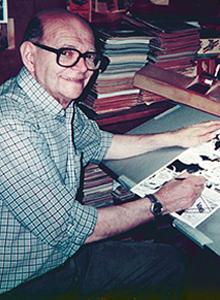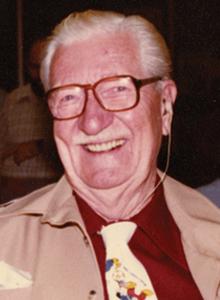Hall Of Fame
Since the founding of the Will Eisner Comic Industry Awards (and their previous incarnation, the Kirby Awards), the following individuals have been inducted into the Hall of Fame.

Neal Adams
1941- 2022
Neal Adams’ work on such titles as Batman, Deadman, and Green Lantern/Green Arrow brought not only a more realistic look to comics but took many liberties with page layout and cover design. In addition, his studio, Continuity Associates, served as a spawning ground for new talents in the field. Adams is also an outspoken advocate for creator rights in the comics industry.
Inducted 1998

Charles Addams
1912–1988
Cartoonist Charles “Chas” Addams is best known for his macabre humor, exemplified in the Addams Family cartoons, which gave rise to the TV series and films. Addams became a freelance cartoonist in the early 1930s. He sold his first drawing to the New Yorker in 1932. His cartoons ran regularly in the magazine from 1938 up until his death. Addams drew more than 1,300 cartoons over the course of his life. Those that did not appear in The New Yorker were often in Collier’s and TV Guide. In 1961, Addams received, from the Mystery Writers of America, a Special Edgar Award for his body of work. His cartoons appeared in book collections, calendars, and other merchandising.
Inducted 2018

Murphy Anderson
1926–2015
Murphy Anderson’s name is synonymous with the Silver Age of comics at DC. Teaming with Carmine Infantino in the late 1950s and early 1960s, he brought a distinctive look to the company’s science fiction titles, especially Adam Strange in Mystery in Space. He is also known for drawing Hawkman, Atom, Green Lantern, and Atomic Knights.
Inducted 1999

Ross Andru
1927–1993
Artist Ross Andru is best known for his collaborations with inker Mike Esposito and for co-creating the Metal Men (with Robert Kanigher) and the Punisher (with Gerry Conway). Andru and Esposito began collaborating at DC Comics in the early 1950s, on war comics (Our Army at War, Our Fighting Forces, Star Spangled War Stories), The Flash, Metal Men, and a memorable run on the Silver Age era of Wonder Woman (1958–1967).
Inducted 2007

Jim Aparo
1932–2005
Jim Aparo’s first comic book work was at Charlton in the late 1960s. He worked on several genres there and was eventually recruited by editor Dick Giordano for a move to DC Comics in the late 1960s, where he handled such features as Aquaman and Phantom Stranger before landing the art chores on DC’s premiere team-up book The Brave and the Bold (starring Batman). He then co-created (with Mike W. Barr) Batman and the Outsiders, which he drew from 1983 to 1985. Aparo went on to draw stories for Batman (most notably “A Death in the Family” storyline), Detective, and other DC titles into the late 1990s. For most of his career, Aparo not only pencilled his work but inked and lettered it as well.e. He is also known for drawing Hawkman, Atom, Green Lantern, and Atomic Knights.
Inducted 2019

Sergio Aragonés
1937–
Sergio Aragonés has been called everything from “the Fastest Cartoonist in the World” to “the Most Beloved Man in Comics.” Besides having drawn cartoons for MAD magazine for nearly 50 years, Sergio is the creator of the long-running series Groo the Wanderer and has produced such other works as Mighty Magnor, Fanboy, and Actions Speak.
Inducted 2002

Ruth Atkinson
1918–1997
Ruth Atkinson was one of the many female comics artists who worked for publisher Fiction House. She pencilled and inked such features as Clipper Kirk, Skull Squad, and Suicide Smith. She became the company’s art director, a job which she quit because it did not leave her time to draw. She became a freelancer, creating the first issues of Millie the Model and Patsy Walker (co-created with Stuart Little) for Stan Lee at Timely/Marvel. Atkinson later drew for some of the first romance comics, including Lev Gleason Publications’ Boy Meets Girl and Lover’s Lane, through the early 1950s.
Inducted 2021

Dick Ayers
1924–2014
Dick Ayers has had a career spanning seven decades and over 50,000 pages. He started out in comics in 1947 and worked at Magazine Enterprises, Charlton Comics, and Timely/Atlas, where he was known for his art on such western titles as Rawhide Kid, Two-Gun Kid, and Ghost Rider (which he co-created). He became part of the famous Marvel Comics Bullpen in the 1960s and 1970s, working on such titles as The Incredible Hulk, Captain America, and Sgt. Fury and His Howling Commandos.
Inducted 2007

Jerry Bails
1933–2006
Known as the “Father of Comic Book Fandom,” Jerry Bails was one of the first to approach comic books as a subject worthy of academic study, and he was a primary force in establishing 1960s comics fandom. He was the founding editor of the fanzines Alter-Ego, The Comicollector, and On the Drawing Board, the forerunner to the long-running newszine The Comic Reader, designed to showcase the latest comic news. He then headed the drive to establish the Academy of Comic-Book Fans and Collectors. Another important contribution was his Who’s Who of American Comic Books, published in four volumes during 1973–1976.
Inducted 2023

Matt Baker
1921–1959
Best known for his romance and “good girl” comics, Matt Baker started his career in 1944 working for Fox, Fiction House, and Atlas. He is mostly remembered for his work on the Phantom Lady series and the daily Flamingo comic strip. Baker was the artist on the arguably first “graphic novel,” Arnold Drake’s It Rhymes with Lust. He was one of the industry’s first major African American comic book artists.
Inducted 2009

Carl Barks
1901–2000
Known affectionately as “the Duck Man,” Carl Barks wrote and drew hundreds of memorable stories about Donald Duck and his various relatives (most notably Uncle Scrooge, whom Barks created) in comic books from the 1940s to the early 1960s. In retirement, Barks created a number of oil paintings and lithographs featuring the Disney duck characters that achieved high value among collectors.
Inducted 1987

lyNDA BarRY
1956–
Lynda Barry is the creator behind the seminal comic strip Ernie Pook’s Comeek, which was syndicated across North America in alternative weeklies from 1979 to 2008. She is the author of The Freddie Stories, One! Hundred! Demons! (which won the 2003 Eisner Award for Best Graphic Album), The! Greatest! of! Marlys!, Cruddy: An Illustrated Novel, and The Good Times Are Killing Me, which was adapted as an off-Broadway play and won the Washington State Governor’s Award. She has written two bestselling and acclaimed creative how-to graphic novels: Picture This and What It Is, which won the 2009 Eisner Award for Best Reality-Based Work and the R. R. Donnelly Award for highest literary achievement by a Wisconsin author.
Inducted 2016

Alison Bechdel
1960–
Alison Bechdel began her comic strip Dykes to Watch Out For in 1983 and it soon became a mainstay in gay and alternative news weeklies; it ran for 25 years, with Bechdel self-syndicating the strip and eventually publishing it on the Internet. In the 1985 strip “The Rule,” a character states that she will watch a movie only if it has at least two women who talk to each other about a topic other than men. In the 21st century those guidelines became known as the Bechdel Test, a shorthand method to illustrate the dramatic gender disparity in Hollywood. In 2006 Bechdel published the graphic memoir Fun Home, a coming-of-age story that detailed her relationship with her father, a closeted gay man with an obsessive eye for decorative detail, and her own emerging lesbian consciousness. The critically acclaimed work was named a finalist for the National Book Critics Circle Award, and it won the Eisner for best reality-based work. In October 2013 Fun Home was brought to the stage and won a string of awards during its Off-Broadway run. The musical made its Broadway debut in April 2015 and went on to win five Tony Awards.
Inducted 2020

C. C. Beck
1910–1989
Charles Clarence Beck gave the distinctive cartoony look to Captain Marvel when he drew the character for Fawcett. In his later years, he became a beloved curmudgeon in the comics field, and he worked on DC’s first revival of the character (as Shazam!) in the early 1970s.
Inducted 1993

Karen Berger
1958–
Karen Berger entered the comics profession in 1979 as an assistant to editor Paul Levitz at DC. She later became Levitz’s editor when he was writing Legion of Super-Heroes. She soon became editor of House of Mystery and Amethyst, Princess of Gemworld. Berger was instrumental in nurturing Alan Moore’s Swamp Thing and later helped bring Neil Gaiman’s work to a mass audience with The Sandman. The success of these titles led to the creation of the mature-reader Vertigo line in 1993. Titles she shepherded under that imprint include Fables, Hellblazer, 100 Bullets, Preacher, V for Vendetta, and Y: The Last Man. She received the Eisner Award for Best Editor in 1992, 1994, and 1995. In 2013 she stepped down from her post as executive editor & senior vice president of DC Entertainment’s Vertigo imprint. In 2017 Dark Horse Comics announced that she would be heading the imprint Berger Books, which launched in 2018.
Inducted 2018